Cheetah reintroduction in India
Reintroduction of the cheetah in India involves the re-establishment of a population of cheetahs into areas where they had previously existed but were hunted into extinction during and after the Mughal Period, Rajput and Maratha Indian royalty and later by British colonialists, until the early 20th century when only several thousand remained. The Mughal emperor Akbar kept Cheetahs for hunting gazelle and blackbucks. Trapping of large numbers of adult Indian cheetahs, who had already learned hunting skills from wild mothers, for assisting in royal hunts is said to be another major cause of the species rapid decline in India as they never bred in captivity with only one record of a litter ever.[1]
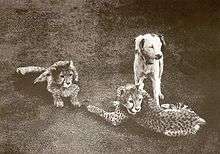
Three of the last Asiatic cheetahs recorded from India were shot down in 1947, by Maharaja Ramanuj Pratap Singh Deo of Koriya. A part of the reintroduction process is the identification and restoration of their former grassland scrub forest habitats.[2] This is within the scope of the duties of the local forest department of each State, where relocation occurs, through the use of Indian Central Government funding.
Background
History
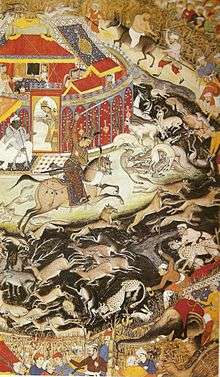
Until the 20th century, the Asiatic cheetah was quite common and roamed all the way from Israel, the Arabian Peninsula to Iran, Afghanistan and India. In India, they ranged as far south as the Tirunelveli district of Tamil Nadu. The Asiatic cheetah, also known as the "hunting leopard" in India was kept by kings and princes to hunt gazelle; the Mughal emperor Akbar kept them for hunting gazelle and blackbucks. He was said to have had 1,000 cheetahs at one time for assisting in his royal hunts, a number believed to be overestimated by many sources. Trapping of large numbers of adult Indian cheetahs, who had already learned hunting skills from wild mothers, for assisting in royal hunts is said to be another major cause of the species rapid decline in India as they never bred in captivity with only one litter on record ever.[3]
Extinction
By the beginning of the twentieth century, the species was already heading for extinction in many areas. There were certain places more affected by this problem than others. The Indian reserves were not very thoughtful when creating habitat loss for these oversized cats. The last physical evidence of the Asiatic cheetah in India was thought to be three, all shot by the Maharajah Ramanuj Pratap Singh Deo of Surguja State in 1947, in eastern Madhya Pradesh or northern Chhattisgarh,[4] but a female was sighted in Koriya district, in what is now Chhattisgarh, in 1951.[4]
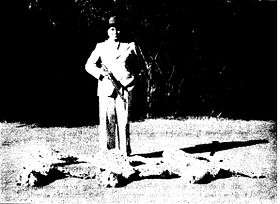
In India in the mid-20th century, prey was abundant, and cheetahs fed on the blackbuck, the chinkara, and sometimes the chital and the nilgai.
...is in low, isolated, rocky hills, near the plains on which live antelopes, its principal prey. It also kills gazelles, nilgai, and, doubtless, occasionally deer and other animals. Instances also occur of sheep and goats being carried off by it, but it rarely molests domestic animals, and has not been known to attack men. Its mode of capturing its prey is to stalk up to within a moderate distance of between one to two hundred yards, taking advantage of inequalities of the ground, bushes, or other cover, and then to make a rush. Its speed for a short distance is remarkable far exceeding that of any other beast of prey, even of a greyhound or kangaroo-hound, for no dog can at first overtake an Indian antelope or a gazelle, either of which is quickly run down by C. jubatus, if the start does not exceed about two hundred yards. General McMaster saw a very fine hunting-leopard catch a black buck that had about that start within four hundred yards. It is probable that for a short distance the hunting-leopard is the swiftest of all mammals.
— Blanford writing on the Asiatic Cheetah in India quoted by Lydekker[5]
With the death of the last remaining population of the Asiatic cheetah in India, the species was declared extinct in India; it is the only animal in recorded history to become extinct from India due to unnatural causes.[6] A consequence of the extinction of the cheetahs and subsequently the Indian royalty that prized them was that their grasslands homes came to be controlled, used and managed by local people. "The grasslands faded and diminished under the hooves of a thousand cattle, they were tilled and ploughed until only a few scattered remnants were preserved in the form of wildlife sanctuaries".
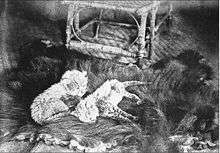
Reintroduction efforts
Cloning
During the early 2000s, Indian scientists from the Centre for Cellular and Molecular Biology (CCMB), Hyderabad, proposed a plan to clone Asiatic cheetahs obtained from Iran. The idea of cloning was introduced by the people concerned with their population, which were few. India requested Iran to transport one live pair to India. If not possible, Indian scientists requested Iran to allow them to collect some live cells of the cheetah pair in Iran itself, which can then be made into living cell lines. They planned to use the nucleus from these cells to manually reproduce their own cheetahs, over a significantly long amount of time. At least the attempt was valid, but the process in receiving these materials was complicated.[7]
Iran refused to say that it would neither send any cheetahs to India nor would they allow Indian scientists to collect their tissue samples. It is said that Iran wanted an Asiatic lion in exchange for a cheetah and that India was not willing to export any of its lions.[6] In 2009, the Indian government contacted Iran again to explore the possibility of Iran supplying cheetahs to help to re-establish their presence on the subcontinent decades after they were hunted to extinction. The Iranian embassy in Delhi had said that its government was in the process of "arranging" talks.[8]
Cheetah Reintroduced In India In 2020 Cheetah Is Back In India After 68 Years Of Delacred Extinct From Country Mysuru:- Cheetah, the fastest running animal on the earth has been arrived on the land of India, from where it was declared extinct from in 1952. The beautiful animal arrived in India on 17 August 2020 and has been kept in Mysuru's Sri Chamarajendra Zoological Gardens, Karnataka.
Possible reintroduction sites
Currently, wildlife experts have shortlisted three regions which have the potential to support cheetah populations. The Nauradehi Wildlife Sanctuary and Kuno-Palpur Wildlife Sanctuaries in Madhya Pradesh and the Shahgarh bulge landscape in Jaisalmer, Rajasthan[9] have been declared potentially suitable for the reintroduction of the cheetah. The Kuno-Palpur Wildlife Sanctuary in Madhya Pradesh has the potential to hold populations of four of India's big cats; the Bengal tiger, Indian leopard, and Asiatic lion and cheetah, all four of which have co-existed in the same habitats historically for many years, before they were wiped out due to overhunting and habitat destruction. Since the Shahgarh Landscape is fenced along the Indo-Pakistani border region, the addition of more fencing will ensure adequate protection for the cheetah population. The Nauradehi Wildlife Sanctuary (1197km2) is part of a much larger forested landscape (5500km2 ) which can host the cheetah as well.[10][11][12]
At a future date, when sufficient population has built up, other former range habitats in India (after revitalizing them) may also be considered for reintroduction like the Banni grasslands and Desert National Park[13][14][15] etc.
A few wildlife groups have suggested the Moyar river valley in Tamil Nadu's Satyamangalam FD, part of Nilgiri Biosphere Reserve as it is a pristine forest with flourishing population of prey and a good record of conservation. Frederick Augustus Nicholson, the then British Collector has reported to have shot a few individuals near Kothamangalam, Velamundi and Bolampatti (all in NBR). This region is on the leeward side of SW monsoon.
Genetic subspecies level differentiation
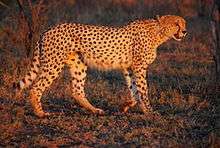
The Asiatic cheetah (Acinonyx jubatus venaticus) has, for a long time, been classified as a subspecies of the cheetah, with the suffix "venaticus" applied at the end of its scientific binomial name Acinonyx jubatus. However, at a cheetah reintroduction workshop organised in India on 9 September 2009, Stephen J. O'Brien from the Laboratory of Genomic Diversity of National Cancer Institute of the United States said that according to the latest genetic studies, the Asiatic cheetah was, in fact, genetically identical to the African cheetah with which it had separated only 5,000 years ago.[16][17] This was not enough time for a subspecies level differentiation; O'Brien said that in comparison the Asiatic and African lion subspecies were separated some 100,000 years ago, and African and Asian leopard subspecies about 169,000 years ago.[18]
Subsequently, in 2011, a much more detailed five-year genetic study involving gathering of DNA samples from the wild, zoos and museums in eight countries was published in Molecular Ecology (Journal) on 8 January 2011. This newer study concluded that African and Asiatic cheetahs were genetically distinct and separated 32,000 to 67,000 years ago. Subspecies level differentiation had taken place due to longer separation from the African population.[19][20][21][22] The effect of this latest revelation on India's plan to reintroduce cheetahs to the country was left unknown.
Introduction of African cheetah
Since the Asiatic cheetah became extinct in India in 1947, plans to reestablish the cheetah in India have been ongoing.[23][24] For this purpose, a meeting of cheetah experts was organized at Gajner in the Indian state of Rajasthan in September 2009. Laurie Marker of the Cheetah Conservation Fund, Stephen J. O'Brien, and other cheetah experts argued for the introduction of the Southern African cheetah as the Asiatic cheetah survives only in Iran and its population numbers less than 100 individuals.[16][17][25] The meeting also identified Namibia, South Africa, Botswana, Kenya, Tanzania, and the UAE as countries from where the cheetah could be imported to India. "About 5 to 10 animals annually have to be brought to India over a period of 5 to 10 years," recommended another working group, which was formed for exploring sourcing and translocation of the cheetah.[6][16][26][27][28][29]
The Ministry of Environment & Forests approved the recommendation for a detailed survey of potential reintroduction sites in the Indian states of Rajasthan, Gujarat, Madhya Pradesh, and Chhattisgarh, which were shortlisted during the consultative meeting. Three more Indian states; Karnataka, Andhra Pradesh, and Maharashtra were also considered. The survey would have formed the basis for the roadmap of reintroduction of cheetah in India, and would have been carried out by the Wildlife Institute of India (WII).[30][31][32][33]
Current Status
The Ministry of forests and environment of India is now hammering out the details of the cheetah conservation plan. As a first step, a two-day seminar of technical experts on cheetahs was held in Gajner from 9 September 2009. Experts on cheetah, including Divyabhanusinh Chavda and M K Ranjitsinh presented their papers on how to go about bringing cheetahs to India.
The initial plans were to bring the cheetahs to Gajner Wildlife Sanctuary. "We want to set up a breeding ground for the cheetahs and Gajner seems to fit the bill perfectly. Thereafter, they will be transported to various states," he added.
India is also in talks with the Islamic Republic of Iran over the possibility of sending a pair of Asiatic cheetahs to India. The Iranian embassy in Delhi said that its government was in the process of "arranging" talks.[6]
The Union Minister of State for Environment and Forests Jairam Ramesh said that African cheetahs could be brought to India within three years having just returned from a trip to South Africa, one of the potential source-habitats of cheetahs to be moved to India.
The Wildlife Institute of India is spearheading the project, and will unveil a road map and destination for the African cheetahs – possible options are in Rajasthan, Madhya Pradesh and Gujarat – by the end of May.[34]
Kuno Palpur and Nauradehi Sancturies in Madhya Pradesh and Shahgarh landscape in Jaisalmer in Rajasthan have been selected in by the Wildlife Institute of India as most suitable sites for the reintroduction project.[35]
In May 2012 the Indian Supreme Court had put the project of importing cheetahs from Africa and reintroducing them in India on hold. Some Conservationists have been fighting a legal battle in Indian Supreme Court to get the Indian State Government of Gujarat to break its monopolizing of wild Asiatic lions and release a few overpopulated prides of lions spilling out of Gir National Park for reintroduction in the Kuno Wildlife Sanctuary in the neighbouring Indian State of Madhya Pradesh which was prepared for them after relocating over 24 villages out of the forest. In the past, for last two decades the State Government of Gujarat had concocted every possible reason to maintain its monopoly on wild Asiatic lions and the tourism revenue generated by them and of recent Gujarat's legal council had put forward the argument that Kuno Wildlife Sanctuary is being used for the introduction of African cheetah which might take several years to fully settle down and repopulate the area and hence reintroduction of lions should only be done after that, this scared the conservationists that Gujarat will use this pretext to delay the reintroduction of native lions by many more decades using the cheetah argument. Indian Supreme court has taken note of the arguments put forth by some Indian conservationists that importing African cheetah for reintroduction in India is misguided as it is against the International Union for Conservation of Nature's reintroduction guidelines and no clearance had been sought from India's National Board for Wildlife. The Indian Supreme Court has fast tracked the case for the re-introduction of lions to Kuno Wildlife Sanctuary and is hearing it every Monday.[36]
Senior advocate PS Narasimha, court-appointed adviser and the amicus curiae in the Asiatic lion's relocation case in India's Supreme Court, filed an application seeking a stay on the implementation of African cheetah reintroduction project in India. The Indian Supreme court had granted the stay and the matter has been scheduled for further hearing in July 2012 after the court returns from vacation. During its hearings, the Bench was informed that India's Ministry of Environment and Forests (MoEF) has decided to introduce the Southern African cheetah (Acinonyx jubatus jubatus) from Namibia into Kuno Wildlife Sanctuary in the Indian state of Madhya Pradesh, the same proposed habitat being developed as the second home for the translocation of lions from Gir Wildlife Sanctuary in the neighbouring Indian state of Gujarat which did not want to shift any lions out of the state. Narasimha said the proposal for reintroduction of African cheetah "has not been either placed before the Standing Committee of India's National Board for Wildlife, nor has there been a considered decision taken in this regard". He stated in an application that "scientific studies show that the African cheetahs and Asian Cheetahs are completely different, both genetically and also in their characteristics" and the reintroduction of African cheetah in India was also against the International Union for the Conservation of Nature (IUCN) guidelines on translocation of wildlife species. "In fact, the (IUCN) guidelines categorically warn against the introduction of alien or exotic species. The African Cheetah obviously never existed in India. Therefore, it is not case of intentional movement of an organism into a part of its native range," the application stated. Asiatic cheetah became extinct in India in the 1950s, In the past, India's last recorded cheetah in the wild was said to have been shot in the Rewa area of Madhya Pradesh in the late 1940s. It was mentioned that the introduction of alien or exotic species is universally shunned by wildlife experts and "in fact countries such as South Africa, Australia are spending huge amount of funds to eradicate and remove exotic wildlife species from wilderness areas or wild habitats". Narasimha also sought a direction of India's Ministry of Environment and Forests (MoEF) to produce before the apex court all relevant records and decisions relating to introduction of cheetah. He said the Indian cheetah in genetic composition is a different animal than the African cheetah and a different subspecies altogether and "therefore one cannot be introduced in place of the other". Conservationists say no more than 50 of the critically endangered Asiatic cheetah remain only in Iran, roaming the central deserts. The vast majority of the 7,000 cheetahs left in the world are in Africa. [37]
On 28 January 2020, the Supreme Court allowed the central government to introduce Southern African cheetahs to a suitable habitat in India as part of a trial to see if they can adapt. The ruling came in response to an application filed by the National Tiger Conservation Authority (NTCA) seeking permission to introduce Southern African cheetahs from Namibia. The Supreme Court set up a three-member committee to guide the NTCA and asked the committee to submit a progress report every four months.[38][39]
References
- "India to reintroduce cheetah 60 years after 'extinction'". Daily Telegraph. Retrieved 3 September 2018.
- Karnad, D.Plan well to reintroduce Cheetah. http://governancenow.com/views/columns/plan-well-reintroduce-cheetah/
- "| Travel India Guide". Binoygupta.com. 18 May 2012. Retrieved 16 May 2013.
- Divyabhanusinh (1999). The End of a Trail: the Cheetah in India. Banyan Books, New Delhi.
- Lydekker, R. A. 1893-94. The Royal Natural History. Volume 1
- Dey, A. (16 July 2009). "Rajasthan to be home for cheetahs". Times of India. Retrieved 9 August 2009.
- "CCMB's Iran hope for Asiatic cheetah". The Indian Express. 28 January 2003. Retrieved 16 May 2013.
- Lamont, James (5 August 2009). "India tries cheetah diplomacy on Iran". FT.com. Retrieved 16 May 2013.
- "Rajasthan to be home for cheetahs". The Times of India. 26 July 2009.
- Assessing the potential for reintroducing the cheetah in India, 2010. Archived 27 September 2011 at the Wayback Machine A report on the feasibility of cheetah reintroduction in India, jointly prepared by the Wildlife Trust of India (WTI) and Wildlife Institute of India (WII), and submitted to the Ministry of Environment and Forests, Government of India (Ranjitsinh, M. K. & Jhala, Y. V. (2010) Assessing the potential for reintroducing the cheetah in India. Wildlife Trust of India, Noida, & the Wildlife Institute of India, Dehradun, TR2010/001). Also available at WII website: , . Accessed 1 February 2011. Also available at Ministry of Environment and Forests (India) website: Accessed 20 September 2011.
- Project Cheetah (Brochure), September 2010, Ministry of Environment and Forests, Government of India. Accessed 1 February 2011.
- Three Sites Recommended for Reintroduction of Cheetah, Ministry of Environment and Forests, 28-July, 2010, Press Information Bureau (PIB), Government of India
- Gujrat misses out on cheetah, 29 Jul 2010, The Times of India newspaper
- Himanshu Kaushik, TNN 3 October 2009, 01.29am IST (3 October 2009). "Banni Grassland possible home for cheetahs; Himanshu Kaushik, TNN, 3 October 2009; Times of India". The Times of India. Retrieved 16 May 2013.CS1 maint: multiple names: authors list (link)
- , 03.54am IST (12 September 2009). "Cheetahs on their way to Gujarat?; 12 September 2009; The Times of India". The Times of India. Retrieved 16 May 2013.
- "Workshop on cheetah relocation begins, views differ". PTI. Times of India. 9 September 2009. Retrieved 29 January 2020.
- Sebastian, Sunny (20 September 2009). "India joins the race to save Cheetahs". The Hindu. Retrieved 29 January 2020.
- "Experts eye African cheetahs for reintroduction, to submit plan". IANS. Thaindian. 10 September 2009. Retrieved 29 January 2020.
- Charruau P; C Fernandes; P Orozco-Terwengel; J Peters; L Hunter; H Ziaie; A Jourabchian; H Jowkar; G Schaller; S Ostrowski (2011). "Phylogeography, genetic structure and population divergence time of cheetahs in Africa and Asia: evidence for long-term geographic isolates". Molecular Ecology. 20: 706–724. doi:10.1111/j.1365-294X.2010.04986.x. PMC 3531615. PMID 21214655.
- Three distinct cheetah populations, but Iran's on the brink; 18 January 2011; USA TODAY
- Asian cheetahs racing toward extinction; 24 January 2011; Scientific American magazine; retrieved on 29 January 2011
- The Need for Conservation of Asiatic Cheetahs; 17 January 2011; ScienceDaily; retrieved on 29 January 2011
- Cheetahs may soon be on the prowl in Indian woods; by Vinay Madhav; 27 October 1998; The Indian express newspaper
- Book Review: Pug Marks In Time - A superb book documents the history and demise of the cheetah; by Mahesh Rangarajan; 27 March 1996; Outlook India Magazine. Also see BOOK: The End of Trail: The Cheetah in India Third Edition; IDI060; by Divyabhanusinh; Paperback (Edition: 2006); Oxford University Press ISBN 0-19-568697-7
- Marker, Laurie (24 April 2018). "Cheetah reintroduction in India is a project worth revisiting". Down to Earth. Retrieved 29 January 2020.
- Ravindran, Shruti (5 October 2009). "Spotted: Lean Cat Rerun". Outlook. Retrieved 16 May 2013.
- More places identified for housing cheetah; by Anindo Dey, TNN; 11 September 2009; Times of India
- Cheetahs on their way to Gujarat? 12 September 2009; Times of India
- India plans return of the cheetah - India plans to bring back the cheetah, nearly half a century after it became extinct in the country. The BBC's Soutik Biswas considers whether it is a good idea.; 20 September 2009; BBC News.
- "Are the plans to bring the cheetah to India still on? / Yes, they are very much on. We have asked the Wildlife Institute of India to prepare a roadmap. We had given them three months, which will expire end of February. So the project is very much on." We got our way with Obama - Interview with Jairam Ramesh, Environment and Forests Minister (of the Central Government of India); By Soni Mishra; 31 JANUARY 2010; The Week, India
- EnvironMin seeks roadmap on reintroducing Cheetah; 8 October 2009; Eco News; ZEE NEWS
- India agrees to cheetah survey - The Indian government has approved a survey of sites which can accommodate the cheetah, in an effort to reintroduce the animal in the country. 9 October 2009; BBC News
- Ministry nod for Cheetah re-introduction project - Jairam Ramesh conveyed decision to WTI; by Aarti Dhar; 9 October 2009; The Hindu; Online edition of India's National Newspaper, Also see
- "African cheetahs can be relocated to India in three years, says Jairam". The Hindu. Chennai, India. 27 April 2010.
- "Centre Clears Three Sites as Habitats for Cheetah". news.outlookindia.com. Archived from the original on 16 July 2012. Retrieved 16 May 2013.
- Asiatic lion may roar at new home in Kuno-Palpur sanctuary, Ahmedabad/New Delhi, 09/May/2012, Daily Bhaskar; Gujarat, MP fight for Asiatic lions’ share, Source: DNA, 01/May/2012, Daily Bhaskar
- Asiatic lion may roar at new home in Kuno-Palpur sanctuary, Source: DNA, 09/May/2012, Daily Bhaskar; Supreme Court stalls Centre’s plan to reintroduce cheetahs in India, Kumar Sambhav S..., 8 May 2012, Down To Earth, DTE; SC stays Cheetah Re-introduction Project, 8 May 2012, PTI, Deccan Herald
- "Supreme Court allows Centre to bring African cheetah to suitable wildlife habitat in India". IANS. The Hindu. 28 January 2020. Retrieved 29 January 2020.
- "Court paves way for African cheetahs to be shipped to India". AFP. 28 January 2020. Retrieved 29 January 2020.
Further reading
- Assessing the potential for reintroducing the cheetah in India, 2010. A report on the feasibility of cheetah reintroduction in India prepared by the Wildlife Institute of India (WII), and submitted to the Ministry of Environment and Forests, Government of India (Ranjitsinh, M. K. & Jhala, Y. V. (2010) Assessing the potential for reintroducing the cheetah in India. Also available at WII website: , . Accessed 1 Feb 2011. Also available at Ministry of Environment and Forests (India) website: Accessed 20 Sept 2011.
- Project Cheetah (Brochure), September 2010, Ministry of Environment and Forests, Government of India. Accessed 1 Feb 2011.
- Return Of The Cheetah?; October 2010; Sanctuary Asia magazine; India. Accessed 1 Feb 2011.
- Spotted: Lean Cat Rerun; Hunted out from Indian grasslands, the cheetah may tear across the landscape again; Shruti Ravindran; 5 October 2009; outlookindia magazine. Accessed 1 Feb 2011.
External links
- Reintroducing the Cheetah in India
- Video of Indian Cheetah being used for hunting Blackbuck, 1939
- Video on Youtube: India Cheetah Re-introduction. Uploaded by ccfcheetah on 19 January 2012; The Cheetah Conservation Fund has been working on and advisory capacity with the Wildlife Trust of India and India's authorities to discuss the best strategies for re-introducing cheetahs in India. For more information visit www.cheetah.org
- Video on Youtube: Movie 'Cheetahs in Iran; the last stronghold of the Asiatic cheetah. Uploaded by kohvasang on 31 October 2011. this movie shows how they find the cheetahs in desert of iran. A video report which shows how Iranians and an international team cooperate to save scattered Cheetahs in Iran.
- https://www.vvdatalink.com/knowledge/wildlife/asiatic-cheetah-reintroduction-project
